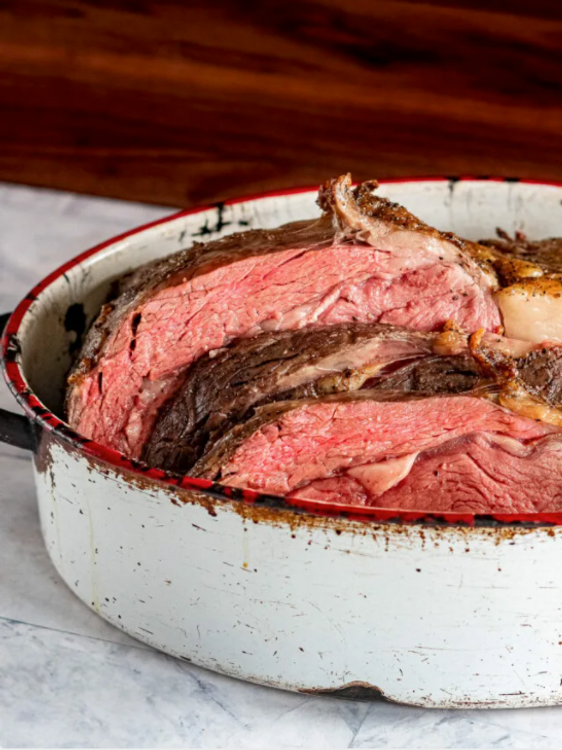How To Make Sous Vide Prime Rib
Posted by Ally from Crave the Good on Sep 28th 2021
Sous Vide Prime Rib is the most tender and juicy prime rib you'll ever have! This method helps to cook your prime rib perfectly without overcooking it. Try cooking this year's Thanksgiving or Christmas prime rib sous vide!
It's kind of funny how easy it is to start a tradition.
One year we hosted a huge Christmas Eve dinner. Kevy and I pulled out all the stops - Prime Rib, GRAVY, MASHED POTATOES, Yorkshire puddings, SALADS, CREME BRULEE, and even HOMEMADE EGGNOG. It was a feast fit for the Kings and Queens around our table.
Since that year, every December, we've upheld the tradition and hosted a Christmas Eve dinner for our friends and family.
And every single year, we go to bed on Christmas Eve with the most profound happiness and gratitude for the love we give and receive.
This sous vide prime rib recipe is dedicated to giving and receiving.
Tips & Tricks
No. 1 --> If you're new to sous vide cooking, check out my SOUS VIDE 101 post for a detailed guide on sous vide!
No. 2 --> The rule of thumb with meat is generally to buy the best grade you can afford, but sous vide allows some flexibility! If you can't find a prime-grade roast, you can certainly use the next best thing.
No. 3 --> Ensure you have a large enough vacuum seal bag! My roast did not fit in my standard 10x13" bags and I struggled to stuff it into an 11" wide roll bag!
No. 4 --> If you love a good beef gravy, check out my CROSS RIB ROAST recipe for a great gravy recipe that's perfect for your prime rib! Follow the same directions and use any bag juices and drippings from the searing pan.
What is Prime Rib?
Prime rib roasts are cut from the rib primal and are renowned for their tender, juicy texture and rich, beefy flavor. The word "prime" generally denotes the grade of beef, so if you're having trouble locating a prime rib roast, look for a standing rib roast - they both refer to the same cut, depending on the grade.
Now it gets more confusing. A full standing rib roast contains 7 ribs, and that's a BIG roast! Butchers will generally cut that full rib roast into 2 pieces, the chuck end and the loin end. The chuck end is located closer to the shoulder and the loin end which is nearer the loin of the animal.
In general, the first 3 ribs come from the chuck end and the other 4 come from the loin end, but that is not a hard and fast rule.
The next question you're going to ask is "which one do I pick?"
That is a personal answer. The chuck end has more fat between the muscles, it usually has smaller bones, and it definitely has the rib cap. If you're a steak aficionado, the rib cap is *chef's kiss*. The loin end has a single eye of meat and no cap, it's leaner but still incredibly tender. The loin end is also easier to carve, and has a better presentation as there is only one large muscle.

To French or Not to French
Frenching bones is simply the art of trimming the fat, meat, and sinew from in between and around the bones. A Frenched roast is simply trimmed for presentation. Some go a step further and cut the ribs completely off of the roast, then truss them back on for ease of carving.
And I get the Frenching thing, I really do, but for the love of God - DO NOT CUT THE BONES OFF!
You're paying a premium for this roast, and you're not afraid of a little knife work!
The bones serve to add flavor to the roast as well as insulating the prime rib and regulating the cooking temperature. The bones also help to prevent moisture loss and therefore help to keep your roast more moist and tender.
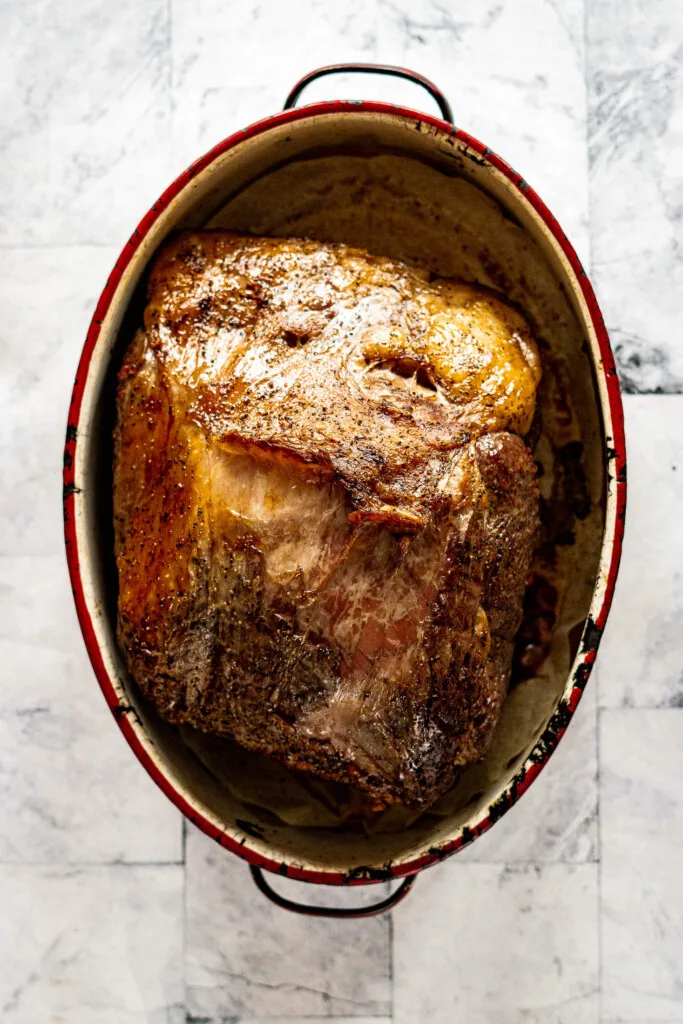
Key Ingredients
Prime Rib: When choosing your prime rib or standing rib roast, look for one with bright red color, great internal marbling, and milky white fat that's evenly distributed along the top of the whole roast.
Kosher Salt: Use coarse kosher salt and apply generously on the surface of the roast. The salt helps to draw internal juices to the surface creating a brine that is easily absorbed by the roast during cooking.

How to Sous Vide Prime Rib
Prepare it:
- Inspect your roast. Remove any loose pieces of fat from the surface, but avoid trimming unless the fat cap is substantial.
- Generously season the entire roast with coarse kosher salt and pepper. Set aside.
- Preheat sous vide water bath to 133f with hot water from the tap and allow the roast to rest until the bath has reached temperature. This allows the roast to rest and absorb the salt and pepper.

Vacuum Seal It:
- Once the water bath reaches temperature, place the prime rib into a vacuum seal bag and if the bones are particularly sharp, add an extra piece of vacuum seal bag over the bone ends. My roast was quite large to fit in the bag, so I added the extra plastic as insurance. Wipe the lip of the vacuum bag to ensure a good seal and seal it up!
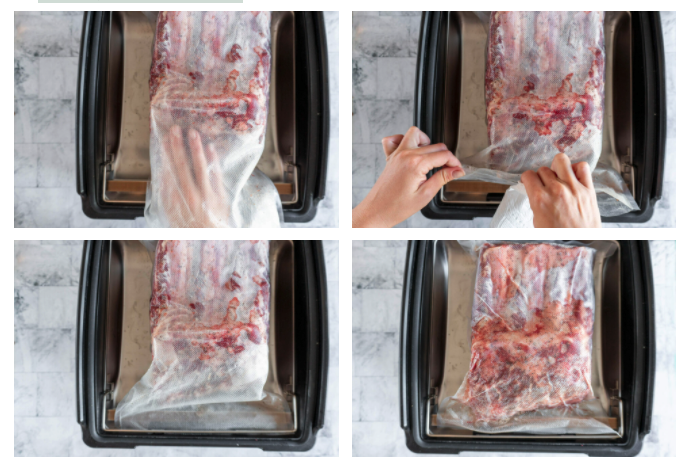
Sous Vide It:
- Carefully lower the sealed prime rib into the water bath and cook at 133f for 6 to 8 hours.
- Once the water bath timer is up, preheat the oven to 500f and prepare a roasting pan by lining it with parchment paper.

Finish It:
- Remove the prime rib from the water bath, carefully open the bag.
- Place the sous vide rib roast on a cooling rack and blot dry with a paper towel. Allow it to rest to further dry the surface. This will help to improve the sear.
- Transfer the prime rib roast to the roasting pan, orient it bone-side down. Brush the surface of the prime rib with olive oil, this is optional but can help accelerate and intensify the sear.
- Place the roast into the preheated oven and allow to cook for 10-15 minutes, until the fat cap has rendered and the whole roast has a nice browned layer.
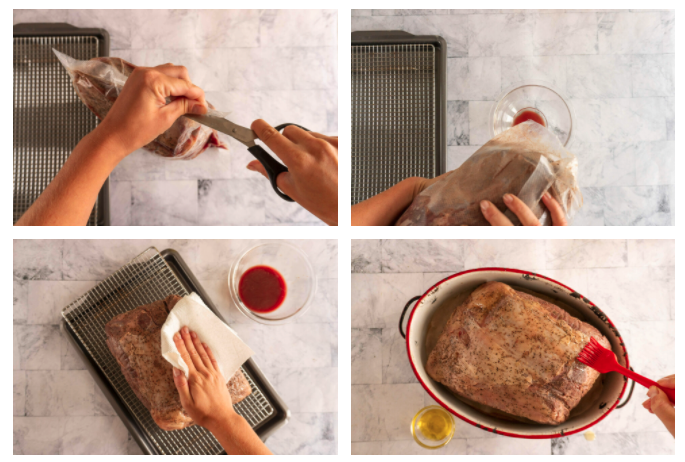
Carve It:
- Remove the roast from the oven and allow it to rest for 15 minutes before carving and serving. To slice easily, hold the roast vertically by the rib bones and slice along the bones to remove them from the roast, then slice the roast into 1/2" slices.
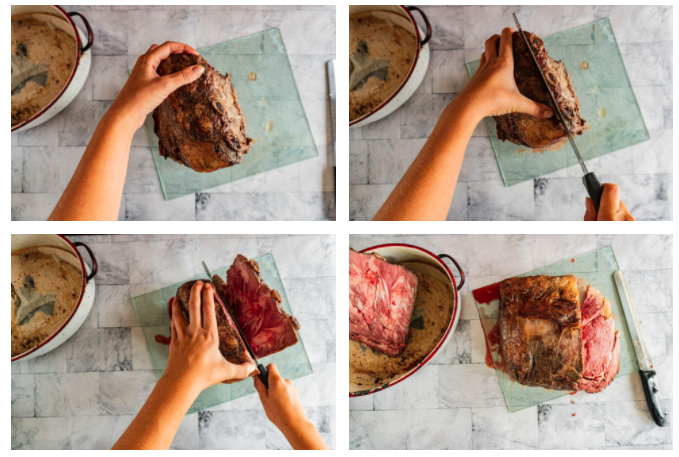
Sous Vide Prime Rib FAQ
- Can I sous vide my prime rib from frozen?
- Absolutely! If you've got the wherewithal to season your roast before sealing it and freezing, I applaud your forethought! Cooking from frozen follows all the same steps as cooking from thawed, except you'll need to add an extra 2 hours.
- What if I want it more or less done?
- Traditionally, prime rib is cooked to rare doneness, with an internal temperature between 120 - 129f. I personally prefer my prime rib to be medium-rare, so somewhere between 130 - 135f. If you like it more towards medium, that's cool too - set your sous vide bath to about 142f - 150f for medium-well.
- My rib roast is smaller/bigger - will it take more/less time?
- If your roast is substantially smaller or larger than 10lbs, I'd recommend altering the cooking time. Aim for 6 hours for a smaller rib roast and around 8 hours for a larger one - that said, this cooking method is very forgiving, so if you leave a roast in a smidge too long it won't have negative effects on the results.
Batch and Storage Information
The yield of your roast depends on the size of your roast. The one cooked in this tutorial is 10 lbs with 3 ribs. This rib roast will feed between 6 and 8 adults. When in doubt, err on the side of caution and cook a larger roast - leftover prime rib sandwiches are heavenly.
Storage: Store any leftover prime rib in an airtight container or bag in the fridge for up to 5 days. To reheat, simply re-vac seal and toss in the sous vide for about an hour, or until heated through. If you have a large piece of prime rib left, it can be slowly reheated in a covered pan in the oven at 300f until heated through.

Recommended Equipment
Vacuum Sealer: Can this recipe be made without one? Sure. Do I trust a $70+ roast to a ziplock style bag? Definitely not! I used my amazing AVID ARMOR USV32 chamber sealer to seal this prime rib. A chamber vacuum evacuates all the air in the chamber then seals the bag, once the air is added back, it creates an instant, tight vacuum that cannot be replicated by bar-style sealers. Check out Avid Armor today, and don't forget to use the code "CRAVE" to save on your purchase!
Sous Vide: I use a cheap little Instant Pot Accu Slim Sous Vide for all my sous vide recipes. It's a few years old, and has never missed a beat! If you're interested in more sous vide machine options, check out my SOUS VIDE FOR BEGINNERS post for alternative options including water ovens.
Blog Post Credit: Ally, Crave the Good

